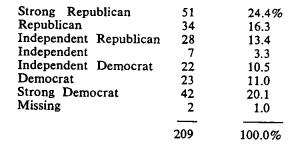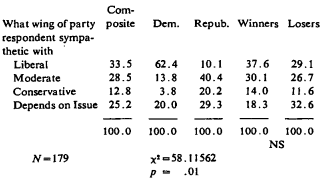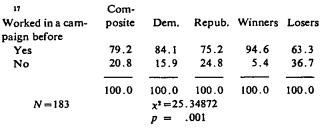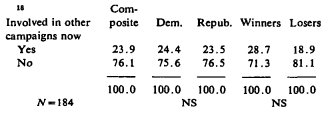Article contents
The Divisive Primary Revisited: Party Activists in Iowa*
Published online by Cambridge University Press: 01 August 2014
Abstract
This study was conducted to test the frequently made assertion that primary elections are divisive among party activists who participate in primary and subsequent general election campaigns. Analysis of data collected from 209 campaign workers personally identified by five candidates in two vigorously contested races for Congress in Iowa's First District indicated that the activists were an elite group on whom the primary had a divisive impact that was particularly notable among those who supported candidates who lost the primary. The alienation felt by many respondents who worked for losers in both parties adversely affected their general party support, voting, and the willingness to perform the many conventional activities necessary to a general election campaign, but it did not appear to have a substantial influence on the general election. Generally, those who defected were less experienced and less strongly identified with their parties than those who remained active. Moreover, most of the antagonism may be limited to the single general election; eighty per cent of all participants in the study expected to be as active or more active in future campaigns.
- Type
- Articles
- Information
- Copyright
- Copyright © American Political Science Association 1974
Footnotes
We want to express our appreciation to the Graduate College of the University of Iowa for support that financed the questionnaire and data processing. We also gratefully acknowledge the assistance of Professor G. R. Boynton and the staff members of the Iowa Laboratory for Political Research, as well as that of colleagues in our department and Fred Greenstein who made some valuable suggestions for the manuscript.
References
1 Key, V. O. Jr., Politics, Parties, and Pressure Groups, fifth ed. (New York: Thomas Y. Crowell Company, 1964), p. 342 Google Scholar.
2 Bone stated that “the primaries are also seen as weakening tickets and fostering on adding to party splits,” American Politics and the Party System, fourth edition (New York: McGraw-Hill, 1971), p. 273 Google Scholar; Sorauf noted “the fear that the primary exacerbates party rifts, splits, factions, feuds … the resulting wounds are often deep and slow to heal,” Party Politics in America (Boston: Little, Brown and Company, 1968), p. 211 Google ScholarPubMed; and Keefe listed the arguments against the primary including the fact that it “has contributed to numerous intraparty clashes; particularly bitter primary fights sometimes render the party incapable of generating a united campaign in the general election,” Parties, Politics and Public Policy in America (New York: Holt, Rinehart, and Winston, 1972), p. 4 Google ScholarPubMed.
3 Hacker, Andrew, “Does a Divisive Primary Harm a Candidate's Election Chances?” American Political Science Review, 59 (March, 1965), at 105 CrossRefGoogle Scholar.
4 White, Theodore, The Making of the President, 1960 (New York: Atheneum, 1961), p. 78 Google Scholar.
5 Hacker, pp. 105–110.
6 Key, , Politics, Parties, and Pressure Groups, p. 314 Google Scholar.
7 See Schlesinger's, essay on “Political Party Organization” in The Handbook of Organizations, ed. March, James G. (Chicago: Rand McNally, 1965), p. 774 Google Scholar. Cf. Conway, M. Margaret and Feigert, Frank B., “Motivation, Incentive Systems, and the Political Party Organization,” American Political Science Review, 62 (December, 1968), at p. 1172 CrossRefGoogle Scholar.
8 Schwengel's 1969 party unity Score was 47 per cent on Congressional Quarterly's overall scale of selected issues in the 90th Congress. He supported President Nixon 72 per cent of the time. Congressional Quarterly, January 16, 1970, pp. 175 and 153Google Scholar.
9 We gave the method of selecting the respondents careful consideration, and decided that by tapping the outstanding workers identified by the candidates, we would poll a unique group not previously examined at the primary level. A survey of a random sample of workers would have been both impractical and irrational; the total number of consistently active participants in the primary effort was too small and too unevenly distributed. Two of the five candidates had only partially developed organizations, but we wanted to question at least those members of their organizations they thought were most important to their campaigns in each county.
10 Although all partisans were identified by their candidates as members of their party, the questionnaires were completely anonymous and the statement above merely means that seven respondents chose not to answer the party identification question. This omission is reflected in our computations.
11 The 202 respondents identified themselves by party as follows:

12 For a discussion of the relation between primary competition and party strength that would have predicted this turnout, see Turner, Julius, “Primary Elections as the Alternative to Party Competition in ‘Safe’ Districts,” Journal of Politics, 15 (May, 1953), 197–210 CrossRefGoogle Scholar, and Key, V. O., American State Politics (New York, Alfred A. Knopf, 1956), pp. 104–113 Google Scholar. The primary vote was impressive. Cf. the study of turnout for U.S. Representative by Wolfe, Arthur C. cited in Ranney, Austin, “Turnout and Representation in Presidential Primary Elections,” American Political Science Review, 66 (March, 1972) at p. 23 Google Scholar.
13 See Crotty, William J., “The Social Attributes of Party Organizational Activists in a Transitional Political System,” Western Political Quarterly, 20 (Sept., 1967) 669–681 CrossRefGoogle Scholar; Patterson, Samuel and Boynton, G. R., “Legislative Recruitment in a Civic Culture, Social Science Quarterly, 50 (Sept., 1969) 243–263 Google Scholar; Boynton, G. R., Hedlund, Ronald, and Patterson, Samuel, “The Missing Links in Legislative Politics: Attentive Constituents,” The Journal of Politics, 31 (August, 1969) 700–721 CrossRefGoogle Scholar; Marvick, Dwaine, “The Middlemen of Politics,” in Approaches to the Study of Party Organization, ed. Crotty, William J. (Boston: Allyn and Bacon, Inc., 1968) pp. 341–374 Google Scholar.
14 Students interested in specific characteristics of and detailed statistics describing the Iowa partisans involved in this study will be sent tables upon request.
15

16 A composite total of 62 per cent of our activists declared that they were most sympathetic with the liberal or moderate wings of their parties. Only 12.8 per cent indicated that their sympathies were with the conservatives. Twenty-five per cent thought that this decision would depend on the issue. This stands in marked contrast to a poll of Iowa citizens taken during the summer of 1971 in which 54 per cent of the sample considered themselves conservatives in politics, 12 per cent were undecided, and 34 per cent called themselves liberals (Des Moines Register, July 4, 1971). The party activists divide with statistical significance between Democrats and Republicans, but in both parties, they were more liberal or moderate than the general electorate. For an interesting contrast with our findings and also between occasional activists in the Republican and Democratic Parties between 1956 and 1964, see Nexon's, David “Asymmetry in the Political System: Occasional Activists in the Republican and Democratic Parties 1956–1964,” American Political Science Review, 65 (September, 1971), 716–730 CrossRefGoogle Scholar.

17

18

19 Cutright, Phillips and Rossi, Peter H., “Party Organization in Primary Elections,” American Journal of Sociology, 64 (November, 1958), at p. 269 CrossRefGoogle Scholar. Cf. Key, , Politics, Parties, and Pressure Groups, p. 314 Google Scholar, and Ranney, Austin and Kendall, Willmoore, Democracy and the American Party System (New York: Harcourt, Brace and Company, 1956) p. 771 Google Scholar.
20 For an analysis of money solicitors as influential middlemen, see Heard, Alexander, The Costs of Democracy (Chapel Hill: University of North Carolina Press, 1960) pp. 259–281 Google Scholar.
21 This is often distinctive; party record keeping in the past has been spectacularly lacking. See Schlesinger, , “Political Party Organizations,” p. 784 Google Scholar.
22 We even tried personally to retrieve questionnaires, but we discovered that many persons, especially teachers, young professionals, and students, had left the district. Others, by November, simply were “tired of politics” and were unwilling to “fill out another form.”
23 Congressional Directory, 92nd Congress (Washington: U.S. Govt. Printing Office, 1971), p. 401 Google Scholar. This was 5,393 fewer votes than were cast in the previous off year election of 1966, but 8,968 more than were cast in 1962.
24 One-quarter of the winners also asserted that they were less active in November, possibly reflecting the fact that many party officials and leaders, who avoid sides in a primary in Iowa, participated in the autumn campaign.
25 These figures tend to confirm the belief of Philip Converse that there is a parallel positive relationship between involvement and party fidelity. See Converse, Philip, “Concept of a Normal Vote” in Campbell, Angus, Converse, Philip E., Miller, Warren E., and Stokes, Donald E., Elections and the Political Order (New York: John Wiley, 1966), chapter 2, p. 33 Google Scholar. For an examination of cross pressures related to voting defections at the national level, see Boyd, Richard W., “Presidential Elections; An Explanation of Voting Defection,” American Political Science Review, 63 (June, 1969) 498–514 CrossRefGoogle Scholar. An excellent summary of research on Within-campaign switchers and the regularity of party voting appears in Sears's, David chapter, “Political Behavior,” in The Handbook of Social Psychology, 2nd ed., Vol. 5, ed. Lindzey, Gardner and Aronson, Elliot (Reading, Massachusetts: Addison-Wesley Publishing Company, 1969), pp. 354–355 Google Scholar. In presidential elections, a rather consistent picture of change emerges: 8 to 11 per cent switches among voters is not abnormal. On p. 344, Sears notes, however, that regularity of party voting is considerably greater for strong party identifiers.
26 We did not ask losing activists if they volunteered to work for the primary winners, but we do know from interviews with Schwengel, Mezvinsky, and their chief advisors that there was no intensive or comprehensive effort made by the winners to recruit people who had been active for the opposition in the primary. Only a few, possibly no more than three to five, Stanley workers volunteered to work in the Schwengel campaign; most of those who continued their political work did shift to other campaigns. On the Democratic side, Mezvinsky has no idea how many Albrecht or Strout workers actively helped him, but he thinks some of them did.
27 For the losers, this could, of course, mean either that they intend to rejoin the victorious wing of the party in the future or that regardless of their temporary setback, they are eager to oppose the primary winner again. On the other hand, this willingness to be active may confirm Richard Boyd's observation that the impact of a candidate on voting defection is substantial but of short duration. Boyd, , “Presidential Elections: An Explanation of Voting Defection,” p. 510 Google Scholar.
- 43
- Cited by



Comments
No Comments have been published for this article.